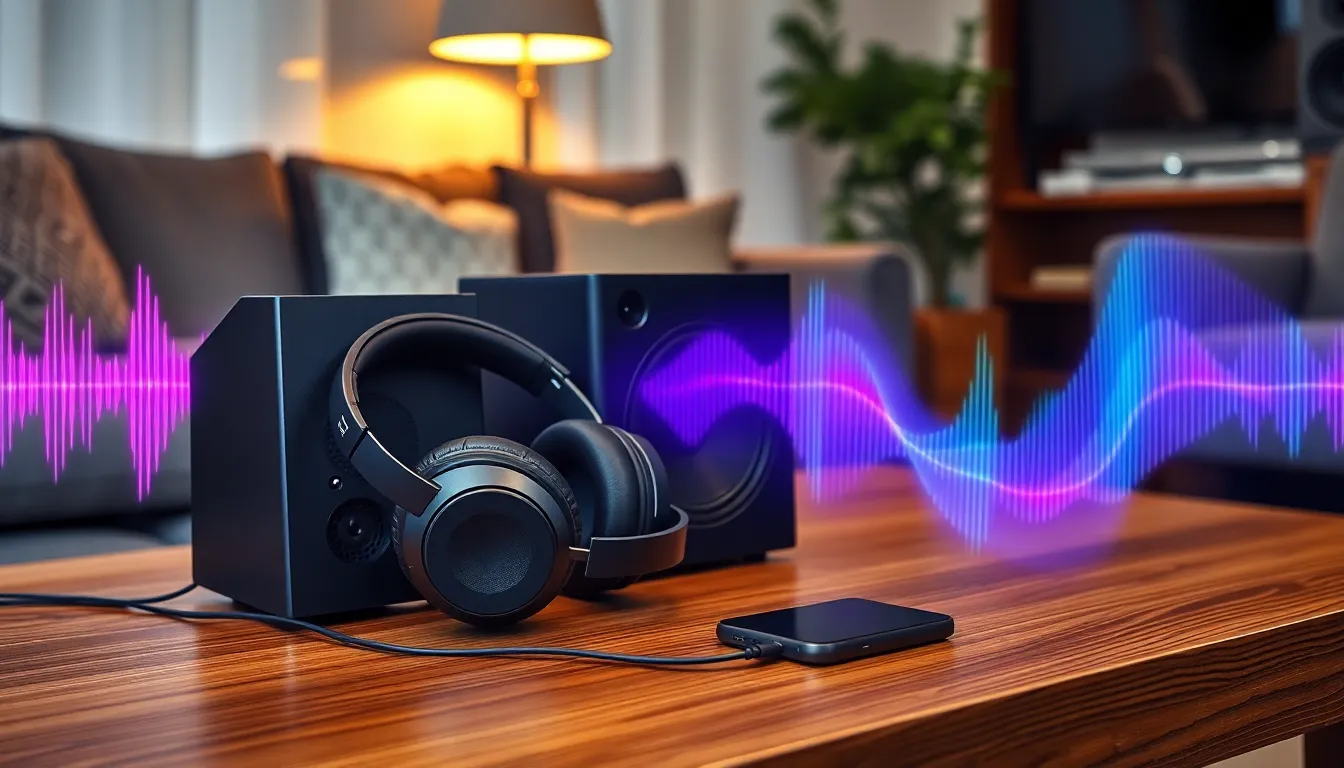In a world where everyone’s chasing the latest tech, sound quality often gets the short end of the stick. People might splurge on flashy headphones but forget that what they’re listening to could be a digital potato. Imagine cranking up your favorite tune only to be greeted by a symphony of static. Yikes!
Table of Contents
ToggleOverview of Sound Quality and Audio Technology
Sound quality plays a crucial role in the listening experience. With advancements in audio technology, consumers often overlook the importance of the audio source. High-end headphones enhance sound but can’t compensate for poor-quality audio files. Digital formats, such as MP3 and AAC, compress sound, which can lead to loss of detail.
Equipment quality significantly affects sound delivery. When using high-fidelity equipment, audio resolution becomes essential. Formats like FLAC and WAV preserve a higher range of sound. Many audiophiles prefer these lossless formats for their superior quality over compressed files.
Audio technology continues to evolve, introducing innovations like spatial audio and high-resolution streaming. Spatial audio creates a 3D sound environment, offering immersive experiences. High-resolution streaming services, such as Tidal and Qobuz, deliver better sound quality compared to standard services.
Understanding specifications helps consumers make informed choices. Terms like frequency response indicate how a speaker reproduces sounds across different frequencies. Knowing its importance enables users to select equipment that aligns with their preferences.
Another key aspect is the role of acoustics. Room acoustics directly influence sound quality, impacting how individuals perceive audio. Using acoustic panels can enhance sound clarity while minimizing unwanted reflections.
Consumers must prioritize both audio source and playback equipment. Investing in quality audio files alongside excellent headphones ensures an optimal listening experience. Balancing these elements leads to improved sound representation and greater enjoyment of music.
Key Factors Influencing Sound Quality

Sound quality depends on several critical factors that shape the listening experience. Understanding these components ensures consumers make informed choices.
Frequency Response
Frequency response measures how well audio equipment reproduces sound across various frequencies. Many headphones and speakers showcase frequency ranges, typically measured in Hertz (Hz). Ideally, the range should cover 20 Hz to 20 kHz to capture the full spectrum of human hearing. Flat frequency response denotes accurate reproduction, while any boosts or cuts in certain frequencies can alter the perceived sound. Quality audio equipment with a balanced frequency response delivers greater clarity and detail, essential for an enjoyable listening experience.
Dynamic Range
Dynamic range refers to the difference between the quietest and loudest sounds in an audio recording. Greater dynamic range enhances the listening experience by providing a more immersive soundscape. Sound equipment with a higher dynamic range allows for subtle nuances in music, making vocals and instruments stand out. For instance, classical music often demands a wide dynamic range to showcase soft passages alongside powerful crescendos. Audio formats that preserve dynamic range, like lossless files, contribute to a more engaging and realistic sound representation.
Total Harmonic Distortion
Total harmonic distortion (THD) quantifies how much distortion occurs when sound reproduces. Lower THD values indicate clearer, more accurate sound, while higher values suggest noticeable distortions. High-quality audio equipment commonly achieves THD levels below 1%, ensuring minimal interference in sound delivery. Music with excessive harmonic distortion can sound muddy, lacking detail and richness. Prioritizing equipment with low distortion rates ensures listeners experience the intended sound, leading to greater enjoyment and satisfaction.
Latest Advances in Audio Technology
Audio technology continues to evolve rapidly, enhancing sound quality and overall experiences. Significant advancements shape how music and sound are delivered, particularly in Digital Signal Processing and High-Resolution Audio Formats.
Digital Signal Processing
Digital Signal Processing (DSP) revolutionizes audio experiences by manipulating sound digitally. DSP enables features like equalization, noise reduction, and spatial enhancements, enhancing clarity and immersion. This technology allows for precise tuning of sound characteristics, ensuring listeners enjoy optimal sound quality. By configuring specific audio frequencies, DSP can adapt to various environments, mitigating issues like distortion. Multiple devices utilize DSP, ranging from headphones to professional sound systems, significantly impacting overall sound delivery.
High-Resolution Audio Formats
High-resolution audio formats meet increasing demands for superior sound quality. Formats such as FLAC and ALAC preserve audio detail, delivering a richer listening experience compared to standard resolutions. Higher sampling rates and bit depths in these formats capture nuances often lost in compressed audio files. Many streaming services now offer high-resolution options, making it easier for consumers to access this content. Embracing these formats allows for a profound appreciation of intricate soundscapes, amplifying enjoyment and engagement with music.
Importance of Sound Quality in Various Applications
Sound quality significantly influences experiences across diverse applications. High-quality sound enhances engagement and enjoyment, making it essential in various fields.
Music Production
Quality of sound plays a vital role in music production. Producers prioritize sound accuracy to ensure that recordings meet industry standards. Clear audio allows musicians to evaluate each note and layer effectively. Engineers use quality monitors to analyze frequencies and dynamics accurately. Critical decisions depend on sound clarity, impacting the final mix and overall listener experience. Avoiding poor-quality equipment and leveraging lossless formats help maintain audio integrity throughout the production process.
Home Theaters
Home theater systems benefit immensely from sound quality. Proper audio enhances viewing experiences by bringing films to life. Consumers invest in surround sound systems to achieve immersive audio. Sound clarity elevates dialogue while emphasizing dynamic scenes. Room acoustics also influence performance, necessitating careful speaker placement and optimal setup. Incorporating high-resolution audio formats ensures details in sound design are retained, enriching the enjoyment of cinematic moments.
Gaming
Gaming experiences thrive on immersive sound quality. Clear audio allows players to perceive subtle cues, enhancing gameplay strategy and enjoyment. Developers design soundscapes to create realistic environments, with spatial audio giving players an edge. High-quality audio equipment enhances engagement, making in-game sounds vital to player success. Gamers often rely on quality headsets or sound systems to enjoy a competitive advantage. Prioritizing audio technology plays a crucial role in delivering impactful, engaging experiences in gaming.
Prioritizing sound quality is essential for anyone seeking an optimal audio experience. High-end headphones and advanced audio technology can only deliver their full potential when paired with quality audio sources. Embracing lossless formats and understanding key specifications like frequency response and dynamic range can significantly enhance listening enjoyment.
As audio technology continues to evolve, consumers should remain aware of the importance of both their equipment and the audio files they choose. Whether for music production, home theaters, or gaming, investing in sound quality will lead to a richer and more immersive experience. By making informed choices, individuals can truly appreciate the nuances of sound and elevate their audio enjoyment to new heights.




